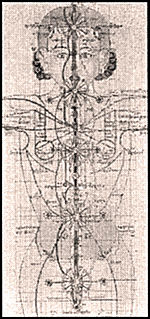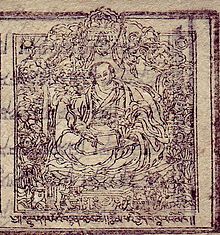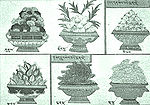- Desi Sangye Gyatso
-
Desi Sangye Gyatso (1653–1705) was the fifth regent of the 5th Dalai Lama (1617–1682) who founded the School of Medicine and Astrology on Chags-po-ri Hill (or 'Iron Mountain') in 1694[1] and wrote the Blue Beryl (Blue Sapphire) treatise[2][3]. The name is sometimes written Sangye Gyamtso.
By some accounts, Sangye Gyatso is believed to be the son of the 5th Dalai Lama[4]. He ruled as regent, hiding the death of the Dalai Lama, while the infant 6th Dalai Lama was growing up, for 16 years. During this period, he oversaw the completion of the Potala palace, and also warded off Chinese politicking. Eventually, the discovery of this deception was not taken kindly by the Chinese emperor Kangxi.
He is also known for harboring disdain for Drakpa Gyeltsen. According to Lindsay G. McCune in her thesis (2007) Desi Sangye Gyamtso refers in his Vaidurya Serpo to the Lama as the "pot-bellied official" (nang so grod lhug) and states that, following his death he had an inauspicious rebirth. [5],
Contents
Iron Mountain
 A drawing from the Blue Beryl illustrating the Tibetan Buddhist view of the chakras (Tib. rsta-khor) and sushumna (Tib. dbu-ma). The tradition emphasizes the existence of five major chakras which are depicted possessing twenty-four spokes said to symbolize their ability to generate and link with the numerous subtle meridians or currents (Tib. rsta). The Brow end Throat centers are associated with the cosmic plane (Tib. stod), the Heart center to the human plane (Tib. bar). and the Solar and Vitality centers to the earth plane (Tb. smad)[6].
A drawing from the Blue Beryl illustrating the Tibetan Buddhist view of the chakras (Tib. rsta-khor) and sushumna (Tib. dbu-ma). The tradition emphasizes the existence of five major chakras which are depicted possessing twenty-four spokes said to symbolize their ability to generate and link with the numerous subtle meridians or currents (Tib. rsta). The Brow end Throat centers are associated with the cosmic plane (Tib. stod), the Heart center to the human plane (Tib. bar). and the Solar and Vitality centers to the earth plane (Tb. smad)[6].
The medical college at Chagpori (lchags po ri; "Iron Mountain") was designed for monastic scholars who would, after learning esoteric arts of medicine and tantrism, mostly remain in the monastery, serving the public as would other monk scholars and lamas. In 1916, Khenrab Norbu, physician to the 13th Dalai Lama, sponsored the construction of a second secular college of Tibetan medicine and Astrology, the Mentsikhang. Mentsikhang was designed as a college for 'laypersons' who would, after receiving training, return to their rural areas for work as doctors and educators.
Six herbs
Six medicinal substances were in common use in Tibet when they appeared in the Blue Beryl Treatise[7][8]:
- Arabic frankincense (Burseraceae) (see on the left, top-left corner);
- Mongolian garlic (see on the left, top-middle)[citation needed];
- Chinese quince (Pseudocydonia) (see on the left, top-right corner);
- Indian embelic myrobalan (Terminalia chebula) (see on the left, bottom-left corner);
- Tibetan ginger (see on the left, bottom-middle)[citation needed];
- South Chinese Kaempferia galanga (see on the left, bottom-right corner);
Popular culture
Fiction
- The Deer and the Cauldron (鹿鼎記): a wuxia novel by Louis Cha. In the story, Desi Sangye Gyatso became the sworn brothers with the novel's main protagonist Wei Xiaobao and the Mongol Prince Galdan Boshugtu Khan (葛爾丹).
References
- ^ Medicine Across Cultures: History and Practice of Medicine in Non-Western Cultures (Science Across Cultures: the History of Non-Western Science) by Hugh Shapiro and H. Selin (2006) p.87
- ^ Healing Powers and Modernity: Traditional Medicine, Shamanism, and Science in Asian Societies by Linda H. Connor and Geoffrey Samuel (2001) p.267
- ^ The Moses Riddle (Treasure Hunter (Bimini Road Publishing)) by Hunt Kingsbury (2004) p.101
- ^ Bryan J. Cuevas, Lhasa in the Seventeenth Century: The Capital of the Dalai Lamas, The Journal of Asian Studies (2004), 63: 1124-1127
- ^ Tales of Intrigue from Tibet's Holy City: The Historical Underpinnings of a Modern Buddhist Crisis Thesis by Lindsay G. McCune The Florida State University College of Arts and Sciences, see page 8 of introduction
- ^ Energetic Healing, Embracing the Life Force by Arnie Lade (1999) p.48
- ^ Gyamtso, S., Klassische Tibetische Medizin (1996) ISBN 978-3-258-05550-3
- ^ Tibetan Medical Paintings: Illustrations to the Blue Beryl Treatise of Sangye Gyamtso (1653-1705 : Plates and Text) by Gyurme Dorje, Yuri Parfionovitch, and Fernand Meyer (1992)
See also
- Ayurveda
- Desi
- Tibetan people
- Traditional Chinese medicine
- Traditional Mongolian medicine
- Traditional Tibetan medicine
- Tree of physiology
External links
Buddhism Categories:- Tibetan people
- Tibetan medicine
- Tibetan physicians
- Regents in Tibet
- Traditional Chinese medicine
- 1653 births
- 1705 deaths
- 17th-century Tibetan people
- 18th-century Tibetan people
Wikimedia Foundation. 2010.


